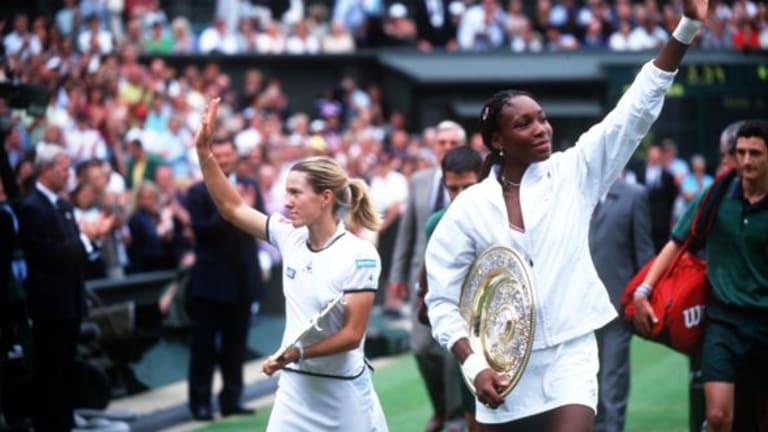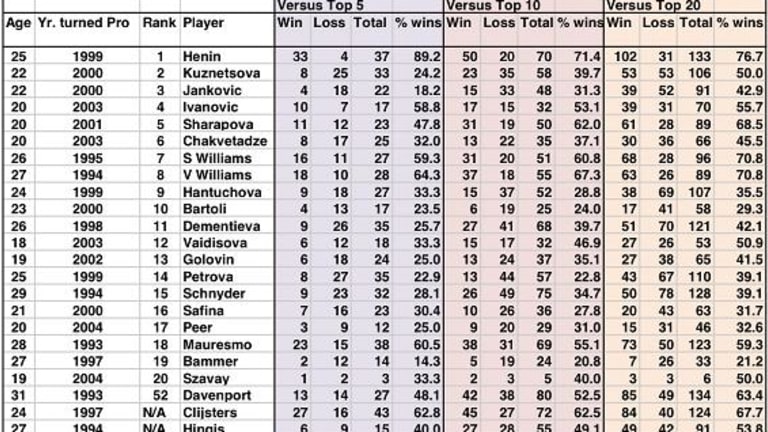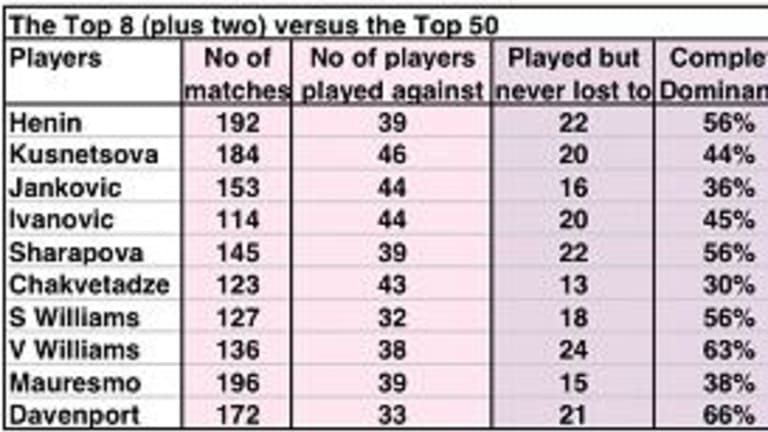Interesting, then, that while Justine Henin has a similar "complete dominance" percentage (i.e. has never been beaten by that player) to Federer's, at 56%, Lindsay Davenport is well ahead of her, at 66%. She hasn't played against as many of the current Top 50 as has Henin, but has a strong record against all that she has played, including a 14-13 head-to-head against Venus Williams. With the exceptions of Serena Williams (who's at 10-4), Maria Sharapova (4-1) and Justine Henin (7-5), Davenport has a winning record against all other current top 50 players that she's played.
Regarding "complete dominance" over other top 50 players - only Maria Sharapova and the Williams sisters can rival Henin and Davenport. Looking more closely at these dominant women in turn:
- Maria Shrarapova has a losing head-to-head against Henin (2-6), Serena Williams (2-4), and Amelie Mauresmo (1-3) while being 3-2 against Venus Williams. In fact, only one other Top 50 player, Victoria Azarenka, has a winning record (1-0) against her. As mentioned above, she's 4-1 against Lindsay Davenport.
- Only two top 50 players have a winning record (1-0 apiece) against Serena Williams - Anna Chakvetadze and Sybille Bammer. She's tied with Henin (6-6), Venus Williams (7-7) and Jankovic (2-2).
- With the exception of Agnieszka Radwanska, who's 1-0 against her, Tatiana Golovin, who's at 2-0, and Lindsay Davenport, against whom she's 13-14, no top 50 players have a winning record against Venus Williams. Incidentally, I watched the match against Radwanska last year, and Venus completed it despite a very obvious wrist injury.
For what it's worth, Amelie Mauresmo, while not as dominant as the women mentioned above, has losing records against only seven Top 50 players - Henin (6-8), Serena Williams (2-9), Venus Williams (3-5), Vaidisova (2-3), Alona Bondarenko (0-1), Lucie Safarova (0-2) and Peng Shuai (0-1). I'm seeing the current cutoff between "Tier 1" and "Tier 2" for the women as coming around here, with Mauresmo in Tier 2. This is debatable - but then, there are those head-to-heads against the more dominant women.
Among others, Anna Chakvetadze has yet to make much impact regarding those significant head-to-heads - she's 1-0 against Serena Williams, and 1-2 against Venus Williams - but otherwise has been dominated by the dominant women. Ana Ivanovic has a 2-2 head-to-head with Maria Sharapova, has never played Davenport, and has no wins against the other three dominants. Jelena Jankovic, as it turns out, can at least say that she has even head-to-heads with both Venus Williams (3-3) and Serena Williams (2-2). But she's 0-9 against Henin, 1-3 against Sharapova, and 1-4 against Davenport. Current world number 2, Svetlana Kuznetsova, is 3-3 with Venus Williams, but has a losing head-to-head against the four other dominant players. None of these players belongs in Tier 1 - the question is really, which ones, if any belong in Tier 2? What does the Tribe think? A working definition of Tier 1 for me would be something like "current Grand Slam contenders, with Slam titles already in the bag". Tier 2 would be something like "possible future Slam contenders, or players with Slam titles who don't look like repeating it."
Finally, I also felt that it would be useful to review career match-winning percentages. Henin has dominated more recently, agaist the current field, but this doesn't necessarily reflect the situation in earlier years, against a somewhat different field. In fact, Henin, Sharapova and the Williams sisters all have 81-82% career-winning percentages, as of now.
By way of a benchmark, I thought that it would be useful to throw in the career-winning percentages of some great female champions of earlier years. Steffi Graf won 89% of her 1,017 career matches; Monica Seles 83% of 717 matches; Chris Evert 90% of 1455 matches; Martina Navratilova 87% of 1653 matches; Billie Jean King 82% of 850 matches; and Evonne Goolagong Cawley 81% of 869 matches. Martina Hingis, incidentally, won 80% of her 681 matches.
Looking at the current percentages versus the higher ones of the past, I was tempted to think that the fact that there is more than one sizeable rivalry in the women's game today may have something to do with the difference. However, not all the top female players play each other particularly often. For example, the Williams sisters have a 7-7 head-to-head, but the last time they met in a tournament was at the US Open in 2005. And, until the 2007 US Open, it was more than four years since Justine Henin had played Venus Williams - so, as Justine won, how much does that 7-2 head-to-head in Venus' favour really mean today? Until 2007 (Key Biscayne) it was also nearly four years since Henin had played Serena Williams, and with three wins to one loss in her favour since then, she has now evened out their head-to-head at 6-6. Meanwhile, Lindsay Davenport's 14-13 head-to-head with Venus Williams is the most prolific one I came across during this exercise, but they haven't met since the 2005 Wimbledon final. Clearly, motherhood, injuries and other matters have kept some women off the tour at different times, but it would be good to see some of these rivalries being more active. Other prolific rivalries of the recent past, by the way, included Henin's with Kim Clijsters, at 12-10, and the 11-10 rivalry between Martina Hingis and Venus Williams. Most others currently contain far less matches.
Finally, I've checked out the current career-winning percentages for the top men - Federer stands at 81% of 685 matches, Nadal at 79% of 324 matches, Djokovic at 70% of 172 matches, Roddick at 76% of 540 matches, Davydenko at 58% of 465 matches, and Ferrer at 59% of 346 matches. All that this tells us is that the dominant women generally seem to have higher career match-winning percentages than the men, and find it easier to dominate lesser rivals.
In fact, comparing the men with the women, the statistics pretty much bear out what is also intuitive - that there is a group of elite women, who are very difficult for the rest of the field to beat, who do, however, have the ability to beat each other, even though one is currently dominant. Whilst, among the men, complete domination of one or more other players is harder to do, with relatively little parity existing at the top of the game.
Note - it's tough to display tables this complex in the format we use here - so I have included two popup windows. [This link should give you a larger version of the first table, and thisis a larger version of the second.]


